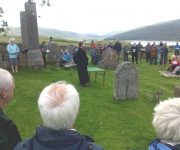[box]
“A! Fredome is a noble thing!
Fredome mays man to haiff liking.
Fredome all solace to man giffis,
He levys at es that frely levys!” –
John Barbour (14th century).
[/box]
If you give people freedom and then try to take it away you can expect a fight, especially if they are Scots. The Covenanters were seen by many, including Walter Scott, as rebels and religious fanatics. Others, such as James Hogg, the Ettrick Shepherd, saw them as victims and martyrs. There is some truth in both camps. In the mid sixteenth century the Reformation gave Scots freedom that had not been available under the Roman Catholic Church. Improved education and printed bibles in English meant Scots could decide for themselves what to believe. James IV/I, brought up in Scotland knew the character of his Scottish subjects well enough not to try and impose the doctrine of the English church on them. His son and grandsons were, tragically, less aware.
In 1603 the people of the south of Scotland had lived in a war zone for three hundred years, more if you include the invasions of the Saxons and the Romans and the tribal conflicts before them. Generations of conflict with little support from central government had bred a tough, resilient and independent minded people. An old Scots-Irish prayer sums them up.
“Lord grant that I always be right.
For thou know how hard I am to turn”
With a Scottish king on the British throne and the long fought Border gone, there should have been the prospect of a peaceful existence. But when the London based kings tried to change the reformed Scottish religion to give them the power and control they enjoyed in England, the Scots rebelled. From 1638, when most of the population of Scotland signed the National Covenant, conflict ensued. Although the Scots acknowledged the authority of the king, they recognised God’s as even higher and their right to access and interpret His word without the need for intermediary bishops or ‘foreign’ creeds. Conflict and occasionally reconciliation followed for the next fifty years.
Over the years positions hardened, battles were fought, atrocities committed and martyrs created. The ejection of ministers who refused to conform led to church services being held, secretly, out in the hills, Conventicles – the participants Covenanters. Punishment was imposed for attending Conventicles and for failing to attend the government prescribed church involving fines and the financially ruinious billeting of soldiers. Summary executions, mutilation, branding, and transportation were all part of the existence of ordinary people, and the worst atrocities and hardship were concentrated in the South-West, escalating in the 1680s and culminating in the ‘Killing Times’.

